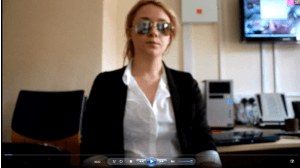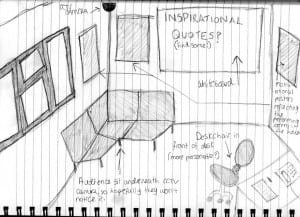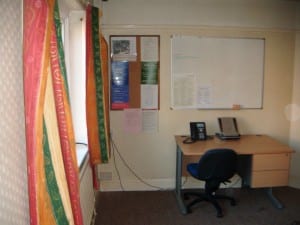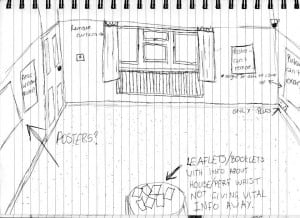After four days and about 16 hours of performing…the safehouse is closed!
There were setbacks, complications and few expressionless audience members, but overall a huge success.
To lay out the scene – firstly a couple would ring the doorbell, where I would answer and ask them the password/phrase, in all cases they did know it, so luckily I didn’t have to shut the door in their faces, then I would take them through to the waiting room, which was minimalistic and fairly dark as the curtains to the window were closed to stop light filtering in, but also to avoid people from the outside as “it is nearly impossible to prevent your gaze from wandering into the private lives of others made suddenly visible” ((Heathcoate, Edwin, (2012), the Meaning of Home, London: Frances Lincoln Ltd, P.99)) and it would ruin the whole performance if the audience could see into the house before they themselves had even entered, as well as destroying the illusion of the ‘safehouse’ because if you can see into it so clearly – how is it safe?
The most challenging parts of my performance were firstly – being professional yet approachable as I found when I performed in a manner that was all corporate with practically no humanity that the audience were more withdrawn, and not as inclined to divulge any information I asked of them. After I had seen this error, I changed my demeanour and added a little more friendliness to my performance, and I saw instantly that almost all of the audience members seemed more relaxed and therefore were able to answer my questions with more ease. Another challenge I faced were difficult audience members, some were absolutely expressionless! It seemed that no matter what I did or said, nothing affected them. Even when I shine an incredibly bright light in their faces, they didn’t even blink. So to counter these types of audiences members, I cut off any of my friendliness, I treated the situation as if were incredibly serious, and for most of those difficult audience members – it seemed to work.
I also encountered several technical difficulties, I made a 3 minute video for the audience, which explains issues such as safety and audience decorum whilst they were in the house, it features Lizzy, portraying Agent L, she simply talks to the camera explaining said issues –
The problems I encountered with this were only small, on two occasions the video would not play, and I had to improvise – asking the audience more questions such as ‘what do you know about the art of spying?’ whilst working on the computer, and trying to get the video to play, which luckily succeeded before too much time had passed. Additionally I learnt after the video had been made, that there was only one fire exit, but had stated there were two on the video, which after it had been played, I reiterated back to the audience, but informed them of the new information, and showed them said fire exit on a map so the audience would have no doubts about what to do in the event of a fire. With the video, I was trying to create a sense of anonymity, letting the audience know that this is infact an operation, it is not just me in a room pretending to be a spy, Agent L is a part of the operation, her eyes are covered, her identity hidden. For those who saw performances where Lizzy was not there, her appearance on the video remains a mystery by building “electronic identities: out there, we are disembodied, depersonalised.” ((Pearson, Mike, (2010), Site-Specific Performance, Palgrave Macmillan, P.125.)) Which I believe adds a more realistic element to the performance.
The most problematic technical problem however were the phones – the CCTV room and I had worked into our performances phone calls back and forth, with at one point whomever was performing in the CCTV room speaking directly to the audience via speakerphone. The problem that ensued were connectivity related – occurring more often than I would’ve like, the person upstairs would miss their queue to ring, and I would have to call them instead, but for some reason the calls would not connect, leaving an awkward silence the first time it happened. Of course after the first encounter with this problem, despite not being able to fix the technical side, I prepared more dialogue and more opportunities for the audience to speak whilst the problem was occurring. With enough foresight I managed to overcome any future possibilities of silent moments, which made for a better performance.
The only other problem I encountered were timekeeping related – making sure I let people into the house at the right time, only having two couples in the house at one time. This was difficult if we overran, or were under the time schedule. Making sure I knew where everyone was at any given time was the biggest responsibility I undertook, and making sure everything ran smoothly was probably the hardest part of the whole performance.
Altogether, I feel like the performance as a whole went incredibly well, and I am proud of my participation in it. I have learnt new things about myself, and found a new sense of self-believe in my abilities which I will carry with me in the future.



